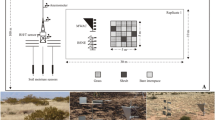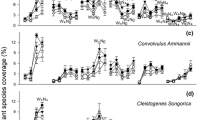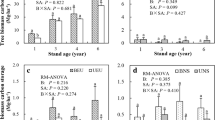Abstract
The aboveground primary production is a major source of carbon (C) and nitrogen (N) pool and plays an important role in regulating the response of ecosystem and nutrient cycling to natural and anthropogenic disturbances. To explore the mechanisms underlying the effect of spring fire and topography on the aboveground biomass (AGB) and the soil C and N pool, we conducted a field experiment between April 2014 and August 2016 in a semi-arid grassland of northern China to examine the effects of slope and spring fire, and their potential interactions on the AGB and organic C and total N contents in different plant functional groups (C3 grasses, C4 grasses, forbs, Artemisia frigida plants, total grasses and total plants). The dynamics of AGB and the contents of organic C and N in the plants were examined in the burned and unburned plots on different slope positions (upper and lower). There were differences in the total AGB of all plants between the two slope positions. The AGB of grasses was higher on the lower slope than on the upper slope in July. On the lower slope, spring fire marginally or significantly increased the AGB of C3 grasses, forbs, total grasses and total plants in June and August, but decreased the AGB of C4 grasses and A. frigida plants from June to August. On the upper slope, however, spring fire significantly increased the AGB of forbs in June, the AGB of C3 grasses and total grasses in July, and the AGB of forbs and C4 grasses in August. Spring fire exhibited no significant effect on the total AGB of all plants on the lower and upper slopes in 2014 and 2015. In 2016, the total AGB in the burned plots showed a decreasing trend after fire burning compared with the unburned plots. The different plant functional groups had different responses to slope positions in terms of organic C and N contents in the plants. The lower and upper slopes differed with respect to the organic C and N contents of C3 grasses, C4 grasses, total grasses, forbs, A. frigida plants and total plants in different growing months. Slope position and spring fire significantly interacted to affect the AGB and organic C and N contents of C4 grasses and A. frigida plants. We observed the AGB and organic C and N contents in the plants in a temporal synchronized pattern. Spring fire affected the functional AGB on different slope positions, likely by altering the organic C and N contents and, therefore, it is an important process for C and N cycling in the semi-arid natural grasslands. The findings of this study would facilitate the simulation of ecosystem C and N cycling in the semi-arid grasslands in northern China.
Similar content being viewed by others
References
Abrams M D, Hulbert L C. 1987. Effect of topographic position and fire on species composition in tallgrass prairie in northeast Kansas. American Midland Naturalist, 117(2): 442–445.
Bachinger L M, Brown L R, van Rooyen M W. 2016. The effects of fire-breaks on plant diversity and species composition in the grasslands of the Loskop Dam Nature Reserve, South Africa. African Journal of Range & Forage Science, 33(1): 21–32.
Barbosa R I, Fearnside P M. 2005. Above-ground biomass and the fate of carbon after burning in the savannas of Roraima, Brazilian Amazonia. Forest Ecology and Management, 216(1–3): 295–316.
Bellingham P J, Tanner E V J. 2000. The influence of topography on tree growth, mortality, and recruitment in a tropical Montane Forest. Biotropica, 32(3): 378–384.
Bennie J B, Hill M O, Baxter R, et al. 2006. Influence of slope and aspect on long-term vegetation change in British chalk. Journal of Ecology, 94(2): 355–368.
Benning T L, Seastedt T R. 1995. Landscape-level interactions between topoedaphic features and nitrogen limitation in tallgrass prairie. Landscape Ecology, 10(6): 337–348.
Blair J M. 1997. Fire, N availability, and plant response in grasslands: a test of the transient maxima hypothesis. Ecology, 78(8): 2359–2368.
Bond W J, Van Wilgen B W. 1996. Fire and Plants. London: Chapman and Hall Press, 42–46.
Briggs J M, Knapp A K. 1995. Interannual variability in primary production in tallgrass prairie: climate, soil moisture, topographic position, and fire as determinants of aboveground biomass. American Journal of Botany, 82(8): 1024–1030.
Brys R, Jacquemyn H, De Blust G. 2005. Fire increases aboveground biomass, seed production and recruitment success of Molinia caerulea in dry heathland. Acta Oecologica, 28(3): 299–305.
Burke I C, Lauenroth W K, Riggle R, et al. 1999. Spatial variability of soil properties in the shortgrass steppe: the relative importance of topography, grazing, microsite, and plant species in controlling spatial patterns. Ecosystems, 2(5): 422–438.
Cabrera M L, Beare M H. 1993. Alkaline persulfate oxidation for determining total nitrogen in microbial biomass extracts. Soil Science Society of America Journal, 57(4): 1007–1012.
Cianciaruso M V, da Silva I A, Batalha M A. 2010. Aboveground biomass of functional groups in the ground layer of savannas under different fire frequencies. Australian Journal of Botany, 58(3): 169–174.
Clark D B, Clark D A. 1996. Abundance, growth and mortality of very large trees in neotropical lowland rain forest. Forest Ecology and Management, 80(1–3): 235–244.
Condon L E, Maxwell R M. 2015. Evaluating the relationship between topography and groundwater using outputs from a continental-scale integrated hydrology model. Water Resources Research, 51(8): 6602–6621.
Corre M D, Schnabel R R, Stout W L. 2002. Spatial and seasonal variation of gross nitrogen transformations and microbial biomass in a northeastern US grassland. Soil Biology and Biochemistry, 34(4): 445–457.
D’Antonio C M, Mack M C. 2006. Nutrient limitation in a fire-derived, nitrogen-rich Hawaiian grassland. Biotropica, 38(4): 458–467.
De Castilho C V, Magnusson W E, de Araújo R N O, et al. 2006. Variation in aboveground tree live biomass in a central Amazonian Forest: Effects of soil and topography. Forest Ecology and Management, 234(1–3): 85–96.
Dudley J L, Lajtha K. 1993. The effects of prescribed burning on nutrient availability and primary production in sandplain grasslands. American Midland Naturalist, 130: 286–298.
Epstein H E, Lauenroth W K, Burke I C, et al. 1997. Productivity patterns of C3 and C4 functional types in the U.S. Great Plains. Ecology, 78(3): 722–731.
Fearnside P M, Leal Filho N. 2001. Soil and development in Amazonia: lessons from the biological dynamics of forest fragment project. In: Bierregaard J O R, Gascon C, Lovejoy T E, et al. Lessons from Amazonia: The Ecology and Conservation of a Fragmented Forest. New Haven: Yale University Press, 291–312.
Gibson D J, Hulbert L C. 1987. Effects of fire, topography and year-to-year climatic variation on species composition in tallgrass prairie. Vegetatio, 72(3): 175–185.
Guo Q F. 2001. Early post-fire succession in California chaparral: Changes in diversity, density, cover and biomass. Ecological Research, 16(3): 471–485.
Hartnett D C, Hickman K R, Walter L E F. 1996. Effects of bison grazing, fire, and topography on floristic diversity in tallgrass prairie. Journal of Range Management, 49(5): 413–420.
Heydari M, Faramarzi M, Pothier M. 2016. Post-fire recovery of herbaceous species composition and diversity, and soil quality indicators one year after wildfire in a semi-arid oak woodland. Ecological Engineering, 94: 688–697.
Hook P B, Burke I C. 2000. Biogeochemistry in a shortgrass landscape: control by topography, soil texture, and microclimate. Ecology, 81(10): 2686–2703.
Houghton R A, Hackler J L, Lawrence K T. 2000. Changes in terrestrial carbon storage in the United States. 2: The role of fire and fire management. Global Ecology & Biogeography, 9: 145–170.
Hulbert L C. 1988. Causes of fire effects in tallgrass prairie. Ecology, 69(1): 46–58.
Jung G, Prange M, Schulz M. 2016. Influence of topography on tropical African vegetation coverage. Climate Dynamics, 46(7–8): 2535–2549.
Kaye T N, Pendergrass K L, Finley K, et al. 2001. The effect of fire on the population viability of an endangered prairie plant. Ecological Applications, 11(5): 1366–1380.
Knapp A K. 1984. Post burn differences in solar radiation leaf temperature and water stress influencing production in a lowland tall grass prairie. American Journal of Botany, 71(2): 220–227.
Knapp A K. 1985. Effect of fire and drought on the ecophysiology of Andropogon gerardii and Panicum virgatum in a tallgrass prairie. Ecology, 66(4): 1309–1320.
Knapp A K, Seastedt T R. 1986. Detritus accumulation limits productivity of tallgrass prairie. BioScience, 36(10): 662–668.
Knapp A K, Conard S K, Blair J M. 1998. Determinants of soil CO2 flux from a sub-humid grassland: effect of fire and fire history. Ecological Applications, 8(3): 760–770.
Laurance W F, Fearnside P M, Laurance S G, et al. 1999. Relationship between soils and Amazon forest biomass: a landscape-scale study. Forest Ecology and Management, 118(1–3): 127–138.
Lavian I L, Vishneretsky S, Barness G, et al. 2001. Soil microbial community and bacterial functional diversity at Machu Picchu, King George Island, Antarctica. Polar Biology, 24(6): 411–416.
Liu W X, Xu W H, Han Y, et al. 2007. Responses of microbial biomass and respiration of soil to topography, burning, and nitrogen fertilization in a temperate steppe. Biology and Fertility of Soils, 44(2): 259–268.
Luizão R C C, Luizão F J, Paiva R Q, et al. 2004. Variation of carbon and nitrogen cycling processes along a topographic gradient in a Central Amazonian forest. Global Change Biology, 10(5): 592–600.
Ma W H, He J S, Yang Y H, et al. 2010. Environmental factors covary with plant diversity-productivity relationships among Chinese grassland sites. Global Ecology and Biogeography, 19(2): 233–243.
Menges E S, Quintan-Ascencio P F. 2004. Population viability with fire in Eryngium cuneifolium: Deciphering a decade of demographic data. Ecological Monographs, 74(1): 79–99.
Moreira A G. 2000. Effects of fire protection on savanna structure in Central Brazil. Journal of Biogeography, 27(4): 1021–1029.
Morrison D A. 2002. Effects of fire intensity on plant species composition of sandstone communities in the Sydney region. Austral Ecology, 27(4): 433–443.
Ojima D S, Schimel D S, Parton W J, et al. 1994. Long- and short-term effects of fire on nitrogen cycling in tallgrass prairie. Biogeochemistry, 24(2): 67–84.
Reynolds H L, Mittelbach G G, Darcy-Hall T L, et al. 2007. No effect of varying soil resource heterogeneity on plant species richness in a low fertility grassland. Journal of Ecology, 95(4): 723–733.
Riihimäki H, Heiskanen J, Luoto M. 2017. The effect of topography on arctic-alpine aboveground biomass and NDVI patterns. International Journal of Applied Earth Observation and Geoinformation, 56: 44–53.
Röver M, Kaiser E A. 1999. Spatial heterogeneity within the plough layer: low and moderate variability of soil properties. Soil Biology and Biochemistry, 31(2): 175–187.
Rowe J S. 1984. Forestland classification: limitations of the use of vegetation. In: Bockheim J G. Forestland Classification: Experiences, Problems, Perspectives. Madison: Department of Soil Science, 132–148.
Safford H D, Harrison S. 2004. Fire effects on plant diversity in serpentine vs. sandstone chaparral. Ecology, 85(2): 539–548.
Saito M, Luyssaert S, Poulter B, et al. 2014. Fire regimes and variability in aboveground woody biomass in miombo woodland. Journal of Geophysical Research-Biogeosciences, 119(5): 1014–1029.
Sariyildiz T, Anderson J M, Kucuk M. 2005. Effects of tree species and topography on soil chemistry, litter quality, and decomposition in Northeast Turkey. Soil Biology and Biochemistry, 37(9): 1695–1706.
Satterthwaite W H, Menge E S, Quintana-Ascencio P F. 2002. Assessing scrub buckwheat population viability in relation to fire using multiple modeling techniques. Ecological Applications, 12(6): 1672–1687.
Schaffers A P. 2002. Soil, biomass, and management of semi-natural vegetation. Plant Ecology, 158(2): 247–268.
Seastedt T R, Briggs J M, Gibson D J. 1991. Controls of nitrogen limitation in tallgrass prairie. Oecologia, 87(1): 72–79.
Shaukat S S, Hussain F, Zafar H, et al. 2014. Species composition, spatial heterogeneity, interspecific association and diversity of an early successional plant community: A comparison of some species association indices. International Journal of Biology and Biotechnology, 11(4): 677–691.
Shetie G M, Dondeyne S, Nyssen J, et al. 2017. Elucidating woody vegetation patterns in relation to soil and topography in tropical Africa: the case of Nech Sar National Park (Ethiopia). Plant Ecology and Evolution, 150: 45–58.
Tilman D. 1993. Species richness of experimental productivity gradients: how important is colonization limitation. Ecology, 74(8): 2179−2191.
Turner C L, Blair J M, Schartz R J, et al. 1997. Soil N and plant responses to fire, topography, and supplemental N in tallgrass prairie. Ecology, 78(6): 1832–1843.
Van Dyke F, Schmeling J D, Starkenburg S, et al. 2007. Responses of plant and bird communities to prescribed burning in tallgrass prairies. Biodiversity and Conservation, 16(4): 827–839.
Vargas R, Allen M F, Allen E B. 2008. Biomass and carbon accumulation in a fire chronosequence of a seasonally dry tropical forest. Global Change Biology, 14(1): 109–124.
Vijayakumar D B I P, Raulier F, Bernier P, et al. 2016. Cover density recovery after fire disturbance controls landscape aboveground biomass carbon in the boreal forest of eastern Canada. Forest Ecology and Management, 360: 170–180.
Vitousek P M, Turner D R, Parton W J, et al. 1994. Litter decomposition on the Mauna Loa environmental matrix, Hawai’i: patterns, mechanisms, and models. Ecology, 75(2): 418–429.
Wahren C H A, Papst W A, Williams R J. 2001. Early post-fire regeneration in subalpine heathland and grassland in the Victorian Alpine National Park, south-eastern Australia. Austral Ecology, 26(6): 670–679.
Wan S Q, Hui D F, Luo Y Q. 2001. Fire effects on nitrogen pools and dynamics in terrestrial ecosystems: a meta-analysis. Ecological Applications, 11(5): 1349–1365.
Whelan R J. 1995. The Ecology of Fire. Cambridge: Cambridge University Press, 112–124.
White T A, Campbell B D, Kemp P D, et al. 2008. Impacts of extreme climatic events on competition during grassland invasions. Global Change Biology, 7(1): 1–13.
Xu W H, Wan S Q. 2008. Water-and plant-mediated responses of soil respiration to topography, fire, and nitrogen fertilization in a semiarid grassland in northern China. Soil Biology and Biochemistry, 40(3): 679–687.
Zhou X, Ge Z M, Kellomaki S, et al. 2011. Effects of elevated CO2 and temperature on leaf characteristics, photosynthesis and carbon storage in aboveground biomass of a boreal bioenergy crop (Phalaris arundinacea L.) under varying water regimes. Global Change Biology Bioenergy, 3(3): 223–234.
Acknowledgements
This study was partially supported by the National Key Basic Research and Development Program of China (2016YFC0500703) and the National Natural Science Foundation of China (31572452, 41573063, 31870438).
Author information
Authors and Affiliations
Corresponding author
Rights and permissions
About this article
Cite this article
Zhao, X., Hu, S., Dong, J. et al. Effects of spring fire and slope on the aboveground biomass, and organic C and N dynamics in a semi-arid grassland of northern China. J. Arid Land 11, 267–279 (2019). https://doi.org/10.1007/s40333-019-0052-3
Received:
Revised:
Accepted:
Published:
Issue Date:
DOI: https://doi.org/10.1007/s40333-019-0052-3




